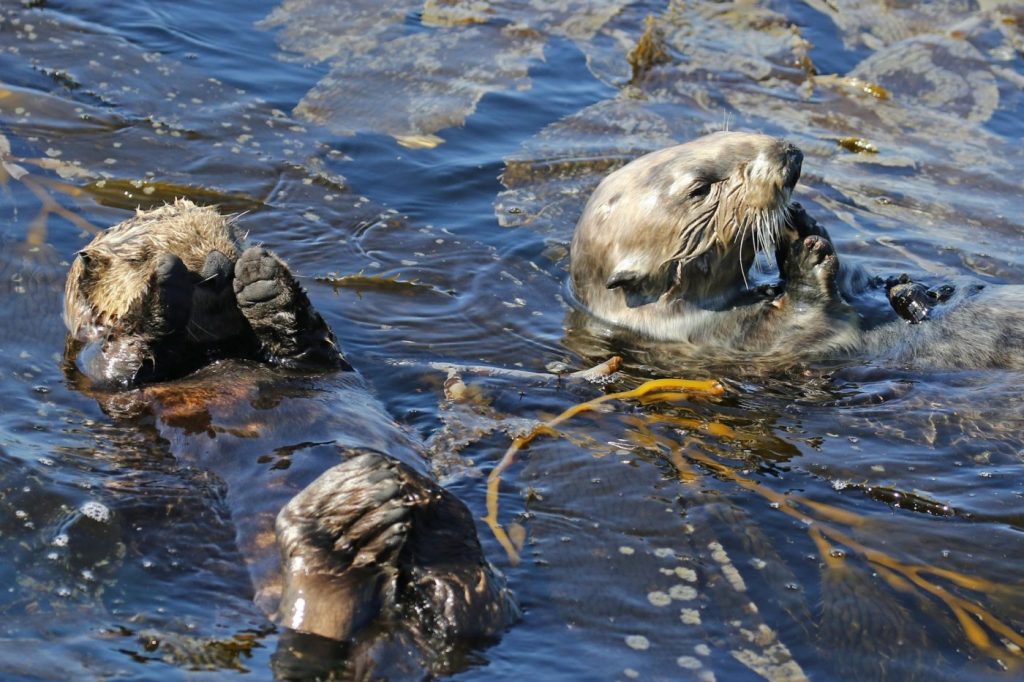MONTEREY — Within the last century, the recovery of southern sea otters, the unofficial mascot of Central California, has contributed to the health of California’s underwater forests according to a new research paper from the Monterey Bay Aquarium.
Researchers found that off the Central Coast, kelp forests are more resilient to climate change and have increased where southern sea otters are present, compared to the decreases Northern and Southern California without sea otters.
“This particular study really demonstrates the value of using historical data to better understand important ecological relationships between top predators, other environmental factors, and changes in our coastal ecosystems, like kelp forests,” said Teri Nicholson, a senior research biologist for the Monterey Bay Aquarium Sea Otter Program and the author of the research paper. “It also helps us and others to develop more informed and effective conservation strategies moving forward.”
The historical data used ship surveys of kelp from 1910-1912 and compared it to aerial surveys of kelp in a similar three-year period of 2014-2016 from the California Department of Fish and Wildlife.
A group of sea otters is called a “raft.” Others also call this a “cuddle party.” (Photo provided by Sea Otter Savvy)
Aquarium researchers found that in Northern and Southern California, within the last century, the kelp forest has declined drastically by 63 and 52 percent, respectively. Meanwhile, in Central California, with the presence of otters, kelp forests have increased by 56 percent.
“The advantage of using the historical data is they’re able to then look at these very broad scale changes, like increases in human density, increases in temperature over a century scale, and then the recovery of sea otters,” said Dr. Tim Tinker, adjunct professor at UC Santa Cruz.
“So when you take this sort of big step back and look at how California has changed over the last 100-120 years, you see the areas that have increased in kelp abundance, mostly explained by where sea otters have recovered.”
One of the disadvantages of using historical data for analysis is the lack of finer details, said Tinker
“You lose a lot of the details of the things that affect kelp abundance month to month or year to year,” said Tinker.
Historical records have shown that the presence of sea otters does have a positive relationship in helping kelp forests come back.
As a result of the fur trade, sea otters were thought to be extinct in the early 1900s. This left many invertebrates like urchins, abalone, and crabs unchecked.
“The decline of otters here meant the growth of the urchin population and the decline of kelp,” said Steve Palumbi, professor and marine biologist at Hopkins Marine Station.
Luckily in 1938, a small raft of around 50 sea otters were found in Big Sur. Over the following years, the population increased and began to spread along the Central Coast.
“When the otters began to come back in the 1960s in Monterey Bay, they ate through all the urchins, and then the kelp forest began to come back,” said Palumbi.
When unchecked, urchins can mow down kelp beds creating “urchin barrens.”
Within the last decade, with detailed research, kelp forests have declined dramatically in Northern and Southern California after major ecological events, but other factors buffer the decline in kelp and help forests rebound.
Kelp forest ecosystems also have other urchin predators than just otters and they can also play a beneficial role.
“One of the things that is now thought pretty well to be true up and down the coast is that there are other predators besides sea otters that are playing a strong role,” said Palumbi. “Sunstars in the north and in the south, there’s the spiny lobster, California sheephead, and wolf eels.”
However, in 2013, the sunflower star started to die out due to a disease called Sea Star Wasting Syndrome. The West Coast was also hit with a marine heat wave deemed “the Blob” that peaked in 2014 and 2015.
With the lack of predators, urchins started to feed on kelp beds, and during an extreme heat wave, the kelp in Northern California was almost completely decimated.
In Southern California, the lack of rocky bottoms where kelp thrives, increased human population, and coastal development over the last century could also be factors in the decline of kelp.
Kelp requires a hard substrate to latch upon. In soft sediment, like sand and mud, kelp forests are almost non-existent.
Extreme heatwaves also have a more significant effect on kelp in the southern waters than in Central and Northern California.
Currently, where kelp is present in Southern California, there are still urchin predators and fisheries that keep the spiny creatures away from kelp.
“Kelp is affected by more than just otters and sea urchins. Kelp is affected by runoff and sedimentation,” said Palumbi. “Over the course of that whole century, a bunch of other things have changed.”
Historical records have shown that the presence of sea otters has a positive relationship in helping kelp forests come back. (Brian Phan — Herald Correspondent)
Southern sea otters are mainly found off the Central Coast.
Where there is a sea otter population, otters can affect the whole ecosystem, and the researchers say they are the primary driver of kelp changes.
Sea otters don’t have a thick blubber layer to stay warm in California’s cold water compared to other marine mammals, like seals and sea lions. Instead, they have thick fur with one million hairs per square inch on certain parts of their body and an extremely high metabolism.
That metabolism and a colossal appetite make them a keystone species with strong interactions in the ecosystem.
Related Articles
Possibility of wildlife-to-human crossover heightens concern about chronic wasting disease
Investigation into killings of 19 burros in California desert hits possible breakthrough
Triplets?! Big Bear eagles welcome 3rd egg of 2024
UC student and a California photographer may have first-ever footage of a newborn white shark
Western Monarch butterfly wintering population is down in California but steady
“They eat a lot of stuff wherever they are,” said Tinker. “That means they have very strong ecological impacts on whatever system they’re in, whether that’s a kelp forest, eelgrass beds, or salt marsh area within an estuary.”
Otters have to consume 25% of their body weight a day and will spend a third of their day eating. That diet includes invertebrates like urchins, abalone, crabs, and clams.
Wherever sea otters are, they’re good at slowing down kelp reduction from urchins.
“Because they don’t feed on urchins in the middle of an urchin barren, they don’t directly remove an urchin barren,” said Tinker. “But they do reduce the spread of urchin barrens and help maintain the resiliency and the resistance of kelp patches from being grazed over by urchins.”
By reducing the spread of urchin barrens, kelp forests can remain healthy. Healthy kelp forests have many positive effects on the ecosystem.
Kelp forests along California consist mainly of two species, the giant kelp in Southern California and bull kelp dominates in Northern California, with a mix off the Central Coast.
“There’s a whole bunch of benefits of having resilient kelp forests: they support a whole bunch of fisheries, reduce coastal erosion, and produce habitat for many different species,” said Tinker.
Kelp forests support many species of sustainable fisheries contributing to California’s economy.
With climate change, more frequent and stronger storms are expected. Research has found that where giant kelp is present, they help mitigate coastal erosion by diverting wave energy.
The reintroduction of sea otters where they were historically found could benefit the health of kelp forests over a long period.
“At this point in time, U.S. Fish and Wildlife Service, which is the managing agency for sea otters, has no plans for reintroductions along the California coastline,” said Nicholson. “But the aquarium is engaged in collaborative research to inform future recovery strategies, like this study that demonstrates the potential benefits to California’s kelp forests.”
Ever since the reintroduction and growing population of sea otters on the Central Coast in the 1900s and the benefits, there has also been pushback from fishermen and fisheries that rely on animals that sea otters will eat.
Today the concern is still there, just in different areas.
In Northern and Southern California, the red sea urchin commercial fishery is a big part of many livelihoods.
In 2022, the red sea urchin commercial fishery was a $10 million industry and is one of California’s top fisheries by volume.
“So there’s positive and negative economic and socioeconomic impacts of sea otters recovering in areas,” said Tinker. “Not everybody in a given community is going to be happy.”
Off the Central Coast, there are not enough red sea urchins to sustain a commercial fishery, most likely due to the presence of sea otters and their ferocious appetite.
“There are people who have problems with the spread of sea otters in Northern California and have valid points to make,” said Tinker. “It’s not a simple answer. I wish it were, but it’s a complex situation.”


